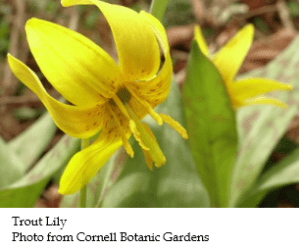

An invitation for you to visit the Cutler Botanic Garden…
The grounds are just waking up; branches blush and buds swell and the earliest flowers are on display. Why not begin your tour in the Shade Garden? Developed in 2015, the area once filled with ostrich ferns and invasive English Ivy now holds several display areas which highlight plants that can succeed in the forest understory, with low light and relatively dry conditions. Master Gardener Volunteer and area team leader Richard Ceponis explains that the design considers more than the horticultural challenges. He says it is important to think of visitors as well. In the shade garden you are invited to follow the curving paths slowly, maybe even stop for a rest at the picnic table which overlooks the shade and perennial gardens.

Before all the lush foliage returns, the shade garden rises from dormancy with beautiful spring blooms. On the right side of the entrance path into the Shade Garden red and yellow primrose pop up in the area that will later be filled with sedges. Early bloomers Winter Aconite and Hellebores can be seen at the top of the Perennial Garden. Further along the Shade path are several lungworts, Pulmonaria, species. These plants are native to forested regions in Europe. Its name reflects the belief of some medieval herbalists that the spotted leaves resembled diseased lungs and might be used as a remedy for respiratory ailments. While not of medicinal value, lungwort’s attractive foliage is a good choice for well drained shady areas. It is not bothered by browsing deer or the presence of black walnut trees. And try not to miss the star magnolia tree in bloom at the opposite end of the path.
Also among those first glimpses of the growing season are native spring ephemerals. For most of the year spring ephemerals are hidden from sight, with their energy stored in underground structures such as bulbs, corms and rhizomes. These plants are found in wooded areas, under the canopy of deciduous trees. In summer the woodland floor is a shady habitat, but during April and May as the weather warms and days get longer, these plants take advantage of their temporary sunny spot. Spring ephemerals complete their above ground life cycle before the canopy fills in. By mid-June tree buds develop into leaves and many of these plants will have faded into dormancy until next spring. Finding these early blooms is a cheery sight after a long winter, and there is something magical about witnessing them before they are gone – like seeing a rainbow. Several spring ephemerals live in the shade garden. Here are some examples:
Bloodroot, Sanguinaria canadensis, produces flowers with 8-12 white petals that emerge wrapped in one large leaf, like a blanket. The blooms are open on sunny days and do not last long. The petals drop within a few days of pollination. Although it is not a very common plant, once established it can spread by rhizomes into nice patches.

Virginia Bluebell, Mertensia virginica, has pink buds that develop into blue trumpet shaped flowers. If you look closely you may find tiny holes at the base of some flowers where “robber bees” have chewed through to collect nectar without climbing into the flower and contacting the pollen.
You need to look under the heart shaped leaves of Wild Ginger, Asarum canadense, to find the maroon to brown flowers. Petals the color of rotting meat and close to the ground work well to attract pollinating insects emerging from the leaf litter of the forest floor.
Red Trillium, Trillium erectum, not only uses color but an unpleasant smell to fool insects looking for carrion. No wonder this flower has been given unflattering nicknames like Stinking Benjamin or Wet Dog Trillium. All plants in the Trillium genus have leaves, petals and sepals in sets of three. Like many ephemerals, they are slow to establish, but can eventually spread.
In the early spring Trout-lily, Erythronium americanum, pops up within the patches of lungwort in the Shade Garden. Trout-lily may take a few years to germinate from seed and several years after that to produce a flower. The flowers are only found on plants with two leaves. A native to this area, it is visited by the trout lily miner bee, a specialist bee who collects pollen only from flowers in the genus Erythronium.

Twinleaf, Jeffersonia diphylla, is a rare plant in New York. Currently there is a single plant in the shade garden. Its flower opens just ahead of the leaf. The folded leaf can briefly look like a green butterfly perched on the flower. Along with Trillium, Bloodroot and Wild Ginger, Twin Leaf attaches an oily food packet called an elaiosome to their seeds. Ants carry them back to underground nests. They eat the elaiosome, leaving the seed safely “planted.”
To catch sight of the rare Twinleaf, all the flowers listed above, and many more, please stop by the Cutler Botanic Garden, free and open to the public everyday dawn to dusk. There is a map at the entrance to help you find your way, and many plants are labeled. Happy Spring!
Written by Erin Gordon, Broome County MGV


